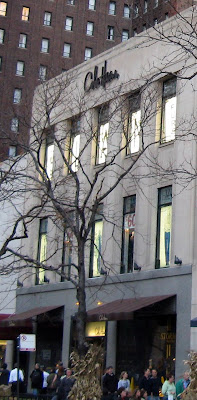What's lies behind this innocuous facade? (original) (raw)
 The French Directorie style in furniture and architecture, a small slice of restrained classicism between the imperial flourishes of the eras of Louis XVII and Napoleon, lasted only about four years, from 1795-99. On North Michigan avenue, however, it's spirit was revived over a century later, where it's survived down to the present day.
The French Directorie style in furniture and architecture, a small slice of restrained classicism between the imperial flourishes of the eras of Louis XVII and Napoleon, lasted only about four years, from 1795-99. On North Michigan avenue, however, it's spirit was revived over a century later, where it's survived down to the present day.
Except you've never seen it, because it's hidden behind the facade of what is now the Cole-Haan store at 673 North Michigan. It was the follow-up to developer Chester and Raymond Cook's Italian Court at Ontario and Michigan, where architect Robert DeGolyer transformed two existing apartment buildings into a conclave of upscale shops around a picturesque interior courtyard.
The Cooks also acquired the Cole-Haan site, in the middle of the next block to the north, and turned to architect Philip B. Maher to create a new facade for the three brick townhouses that faced Michigan Avenue. Author John W. Stamper describes the award-winning facade as featuring "Indiana limestone, a slate roof, wrought iron grills, large windows, and a well-balanced, dignified ornamentation."  It was to be named Malabry Court, after a chateau near Paris that an associate in Cook's office remembered from his service in World War I, when it served as the headquarters of an American hospital unit. At the empty rear half of the site, Maher designed a new building. An art gallery took up the first floor of the new structure. On the second, six apartments were created around an open courtyard. Maher talked about about his design with Chicago Tribune real estate editor Al Chase:
It was to be named Malabry Court, after a chateau near Paris that an associate in Cook's office remembered from his service in World War I, when it served as the headquarters of an American hospital unit. At the empty rear half of the site, Maher designed a new building. An art gallery took up the first floor of the new structure. On the second, six apartments were created around an open courtyard. Maher talked about about his design with Chicago Tribune real estate editor Al Chase:
An interesting feature of the planning of this courtyard is that each of the six apartments that surround it has its own entrance way directly from the court, so that each suite is, in fact, a small individual house.
Through the little stone doorways entrance is made to a large studio . . . with a wood burning fireplace . . . and a kitchenette. A circular staircase, with iron railing, leads to the second floor with its two bedrooms and bath. It'll combine and charm and fascination of the world atmosphere with modern conveniences.
We can't take you inside, but thanks to CAF docent Kathleen Carpenter, we can give you these bird's-eye view of Malabry Court as it survives today, this one slightly doctored to make it more legible. How it's used today, I have no idea. Is it offices? A stockroom? Simply abandoned? In 1932, after the onset of the Great Depression, the Cooks lost the building when the lenders took it over. The upscale shops either closed up or moved on. Kathryn and Harry E. Strickland, "designers and importers of women's gowns", moved in 1930 to larger quarters in the new Medinah Athletic Club, now the Hotel Intercontinental, just down the street. In 1946, Alexander H. Revell, once a famous Chicago furniture company, moved in, abandoning the building Adler and Sullivan had designed for them in 1883, which was demolished in 1968 for the construction of the mammoth Mid-Continental Plaza. At about the same time, the Italian Court has demolished for the construction of 625 N. Michigan.
In 1932, after the onset of the Great Depression, the Cooks lost the building when the lenders took it over. The upscale shops either closed up or moved on. Kathryn and Harry E. Strickland, "designers and importers of women's gowns", moved in 1930 to larger quarters in the new Medinah Athletic Club, now the Hotel Intercontinental, just down the street. In 1946, Alexander H. Revell, once a famous Chicago furniture company, moved in, abandoning the building Adler and Sullivan had designed for them in 1883, which was demolished in 1968 for the construction of the mammoth Mid-Continental Plaza. At about the same time, the Italian Court has demolished for the construction of 625 N. Michigan.
In 1954, the Chicago Tribune reported that Maher's Michigan avenue facades for Malabry Court were to be replaced by "a severely plain steel, glass, and enamel front of ultra-modern design," with those green enamel strips extending the entire 53 foot width of the building, which was then an annex to the Saks Fifth Avenue store to the south. The $150,000 modernization was being initiated by the structure's owner of the moment, the Lambert Tree estate, which also announced another upgrade for the Lambert Tree Studios on State.
That Malabry renovation was never carried out, but the current facade has lost much of Maher's elegant design. The original arched entrances and large shop windows are now a utilitarian gray front, and the ornamental balcony grills along the second floor and graceful cornice are also long gone. The Tribune article referred to the building being extended 13 feet to meet the Michigan Avenue sidewalk. Maher's elevation was, at second and third level, six windows wide. The current has only five. Is this a completely different facade? If anyone has any information on what the changes were, and when they were made, or any information about the apartments themselves, please send it on, and I'll add it to this post.
Those abandoned apartments would have to be a novelists delight, with their faded antique elegance, now squeezed between Apple and Nike, crumbling behind the frenzied mob of commerce that has no idea it even exists. I'd like to think of a 21st century Miss Haversham as a current resident, or the Chicago equivalents of the Collyer brothers, burrowing in twelve-foot stacks of old newspapers and shoulder-high mounds of discarded chicken bones, or Imelda Marcos, living within a cocoon of nothing but shoes, boxed and unboxed, in pairs and alone, on the floor, in the windows, under the bed, in the freezer. Or, thirty years on, Oprah, in long recluse after the move to cable, watching, over and over, holograms of Michael Jackson, Whitney, and Tom Cruise, still crazy after all those years, jumping up and down on her sofa. Aleksandar Hemon, are you listening?
Join a discussion on this story.
© 2009 Lynn Becker All rights reserved.





